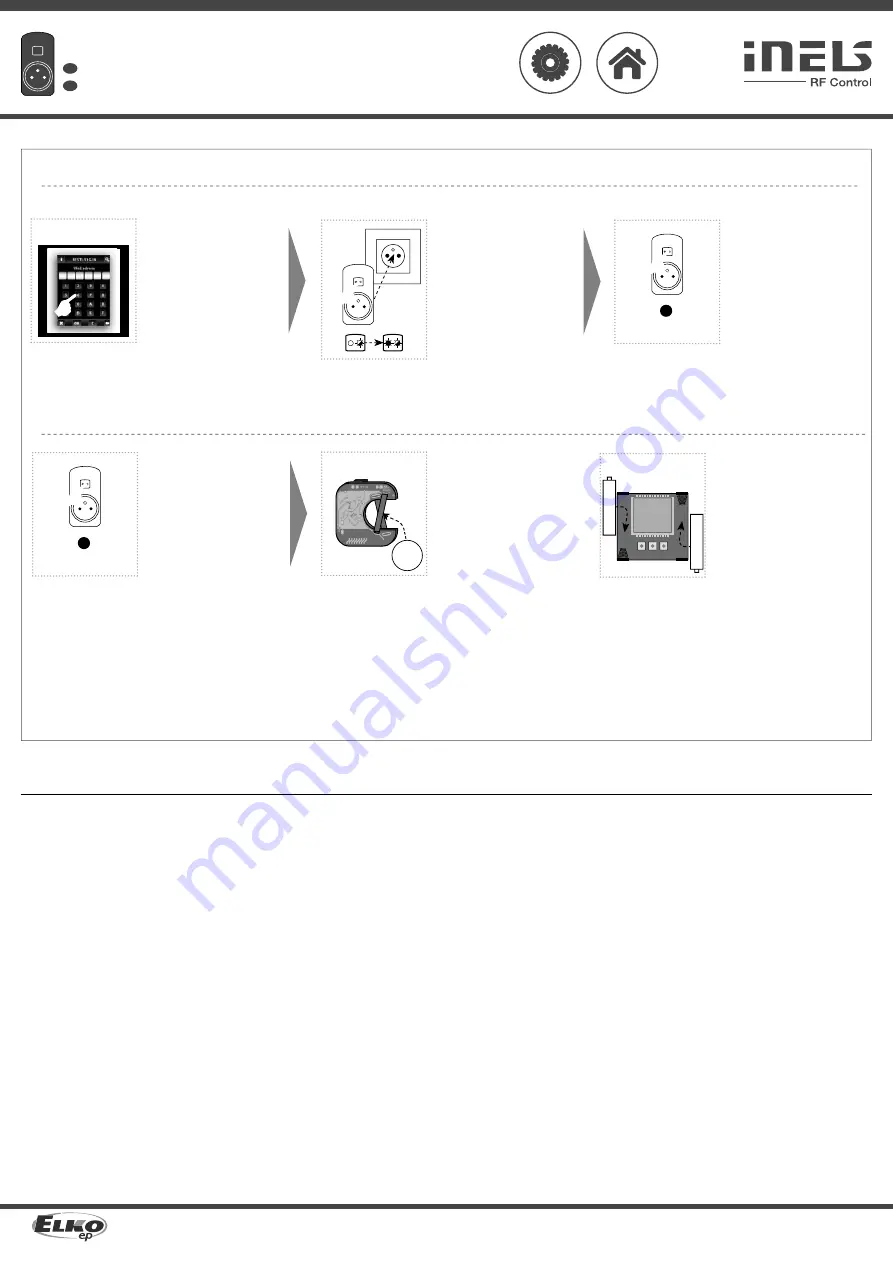
RFRP-20
Repeater to extend the range
EN
02-47/2015 Rev.2
Made in Czech Republic
1
RFTI-10B, RFTC-10/G
3a
PROG
<
1
s
2 x
2
4/5
3b
PROG
<
1
s
1 x
4
+
C
R
2
477
RFTI-10B
4
+
-
+
-
RFTC-10/G
Programming the RFTI-10B (RFTC-10/G) RF with the control unit RF Touch via the RFRP-20.
Programming /
On the RF Touch, the address
is requested of the required
monitoring actuator RFTI-10B
(RFTC-10/G), modifi ed by an
off set.
When inserting the RFRP-20
into an electrical socket (upon
power-up), the programming
button must be pressed. The
green LED fl ashes. Then when
the red LED button illuminates,
release the button.
By two short presses of the
programming button on the
RFRP-20, it moves to the posi-
tion for input into the learning
mode. The red LED illuminates
- after 5s RFRP-20, it enters the
learning mode. The LED goes
out. The entire memory is
thereby deleted.
By one short press of the
programming button on
the RFRP-20, you move
to the position for input
into the additional learning
mode. The red LED fl ashes -
after 5s the RFRP-20 enters
the additional learning mode.
The LED stops fl
ashing.
Addresses already written
in the memory remain
and further programming
with them can continue.
Insert battery CR2477 into the
battery holder of the actuator
RFTI-10B (see instruction manual
for RFTI-10B). This initiates
communication between RFTI-
10B and RF Touch. The RFRP-
20 stores the address in the
memory.
Slide the batteries into the
battery holders of the actuator
RFTC-10/G (see instruction
manual for RFTC-10/G). This
initiates communication
between RFTC-10/G and RF
Touch. The RFRP-20 stores the
address in the memory.
Additional information /
RFRP-20 cannot be placed in a series in order to increase range - communication between the RF
transmitter and RF actuator can go only through a single repeater. Multiple RFRP-20s can be used
in a system, but the same address can be programmed only in a single repeater. If the same address
were programmed into multiple RFRP-20s, mutual interference of individual RFRP-20s could occur
along with feedback (the RFRP-20s would send a command to each other, which would not be
relayed by the RF transmitter, leading to zone congestion and failure of the entire RF system).
When programming the RFRP-20, the risk exists of programming RF transmitters also from a
diff erent RF system within range of the RF signal – e.g. from a neighboring building. Make sure that
in the time of programming within the range of the RFRP-20, no other RF transmitters than the one
you are programming happen to be transmitting.
Repeater - wzmacniacz sygnału
PL
ELKO EP, s.r.o. | Palackého 493 | 769 01 Holešov, Všetuly | Czech Republic | e-mail: [email protected] | Support: +420 778 427 366
ELKO EP Poland, sp. z o. o. | ul. Motelowa 21 | 43-400 Cieszyn | Polska | e-mail: [email protected] | GSM: +48 785 431 024
www.elkoep.com / www.elkoep.pl
Programowanie RFTI-10B (RFTC-10/G) z poziomu urządzenia systemowego RF Touch poprzez RFRP-20.
Programowanie
Do RF Touch wpiszesz adres
wymaganego aktora RFTI-10B
(RFTC-10/G), skorygowany
przez off set.
Wkładając RFRP-20 do gniazdka
elektrycznego (podłączenie
zasilania) naciśnij przycisk
programowania. Zielona dioda
LED miga. Po zapaleniu się
czerwonej diody LED, zwolnij
przycisk.
Dwoma krótkimi naciśnięciami
przycisku do programowania
na urządzeniu RFRP-20,
wybierasz tryb nauki.
Czerwona dioda LED świeci
- po 5s RFRP-20 wchodzi w
tryb nauki, LED zgaśnie. Cała
pamięć zostaje skasowana.
Jednym krótkim naciśnięciem
przycisku do programowania
na urządzeniu RFRP-20
wybierasz tryb douczania.
Czerwona dioda LED miga
- po 5s RFRP-20 wchodzi w
tryb douczania, LED gaśnie.
Wcześniej zapisane adresy
pozostają w pamięci, możesz
zaprogramować kolejne.
Do uchwytu baterii w
urządzeniu RFTI-10B włóż
baterię CR2477 (patrz instrukcja
obsługi RFTI-10B). Uruchomisz
w ten sposób komunikację
między RFTI-10B oraz RF
Touch. RFRP-20 zapisze adres w
pamięci.
Do uchwytu baterii w
urządzeniu RFTC-10/G włóż
baterię (patrz instrukcja obsługi
RFTC-10/G). Uruchomisz w ten
sposób komunikację między
RFTC-10/G oraz RF Touch. RFRP-
20 zapisze adres w pamięci.
Informacje uzupełniające
W celu zwiększenia zasięgu nie można RFRP-20 podłączyć w szeregu - komunikacja pomiędzy
sterownikiem RF oraz aktorem RF może być realizowana tylko poprzez jeden wzmacniacz
RFRP-20. Cały system może korzystać z większej ilości RFRP-20, z tym, że jeden adres może być
zaprogramowany tylko w jednym wzmacniaczu. O ile ten sam adres zostałby zaprogramowany w
kilku RFRP-20, mogło by dojść do wzajemnych zakłóceń pomiędzy RFRP-20 i powstaniu sprzężenia
zwrotnego (RFRP-20 nadawałyby polecenia pomiędzy sobą, które nie byłyby poleceniami ze
sterowników RF, to z kolei doprowadziłoby do zatorów w paśmie i awarii całego systemu RF).
W trakcie programowania RFRP-20 istnieje ryzyko zaprogramowania sterowników RF z innego
systemu RF, który znajduje się w zasięgu sygnału RF - np. z sąsiedniego budynku. Należy się
upewnić, że w trakcie programowania w zasięgu RFRP-20 nie znajduje się żaden inny sterownik RF,
poza tym, który jest aktualnie programowany.





